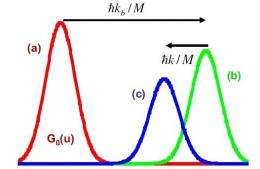September 7, 2010 feature
Scientists examine possibility of a phonon laser, or 'phaser'

(PhysOrg.com) -- While the optical laser celebrated its 50th anniversary earlier this year, some scientists have been working on a new type of coherent beam amplifier for sound rather than light. Scientists theorize that phonons, which are the smallest discrete unit of vibrational energy, can be amplified by a phonon laser to generate a highly coherent beam of sound (particularly, high-frequency ultrasound), similar to how an optical laser generates a highly coherent beam of light. However, phonon laser research is still a relatively new area. In a new study, scientists have for the first time demonstrated the possibility that phonons can be collectively excited in an ultra-cold atomic gas in a way that is similar to how an optical laser excites photons, prompting the scientists to call the proposed device a "phaser."
The first theoretical phonon laser was proposed one year ago, in 2009, by a team of scientists (Kerry Vahala, et al.) from the Max Planck Insitute and Caltech. In that study, the scientists outlined for the first time how a single magnesium ion can be cooled to a temperature of about 1 milli-Kelvin in an electromagnetic trap, and be used to create a single-ion phonon laser. However, the single-ion phonon laser works somewhat differently than an optical laser, since the phonon frequency is determined by the single-atom oscillation frequency rather than corresponding to a collective oscillation.
In the new study, scientists J. T. Mendonca from the Instituto Superior Tecnico (IST) in Lisbon, Portugal, and colleagues from the IST and Umea University in Umea, Sweden, have extended the concept of the single-ion phonon laser to the case of a large ensemble of atoms. In doing so, they have shown that an ultra-cold atomic gas can enable collective phonon excitations. In contrast with the single-ion case, here the phonon frequency is determined by the internal oscillations of the atoms in the gas, similar to how the photon frequency in a laser is determined by internal vibrations of the optical cavity.
“Neither coherent electromagnetic waves, nor coherent sound waves are necessarily difficult to generate,” Mendonca told PhysOrg.com. “It depends on the system of consideration, the frequency range, etc. The difficulty that has been addressed in our work is to copy the laser mechanism, but now generating quanta of sound - phonons - rather than quanta of light - photons. We have shown that cold atom systems can be controlled in great detail, enabling emissions of coherent phonons in a manner copying the celebrated laser mechanism.”
In the new method, the gas is confined in a magneto-optical trap. Three physical processes are used to create the phonon laser instability. First, a red-detuned laser beam cools the atomic gas to ultra-cold temperatures. Then, a blue-detuned laser pumps the ultra-cold atomic gas to create a population inversion, which is also a standard requirement for optical lasers. Finally, the atoms produce a coherent emission of phonons and then decay into a lower kinetic energy state. The scientists note that the resulting acoustic oscillations can then be coupled to the outside world by mechanical or electromagnetic means, where they could be used to provide a source of coherent acoustic radiation.
Regarding the name of a future phonon laser, scientists have previously considered the term “saser” (Sound Amplification by Stimulated Emission of Radiation). But Mendonca and coauthors suggest that “phaser” (where “phonon” is used instead of “sound”) may be more appropriate, since the proposed phonon laser would excite phonons in a way that is very similar to the laser.
“Using the word 'phonon' emphasizes the quantum nature of the process,” Mendonca said. “Saser is certainly an adequate name as well, but we think phaser has a better ring to it.”
A phonon laser could have some useful applications for researchers, although it's likely that more applications are yet to be found. One possible use of a highly coherent beam of ultrasound is that it could allow researchers to greatly improve the imaging resolution in tomography and other imaging techniques.
“It took a while to discover the many applications of the laser - at first it was considered as an invention without a problem to solve,” Mendonca said. “In our work we have been concerned with the basic science issues rather than applications, but hopefully the case of the phaser could be similar to that of the laser.”
More information: J. T. Mendonca, et al. “A phonon laser in ultra-cold matter.” Europhysics Letters, 91 (2010) 33001. DOI:10.1209/0295-5075/91/33001
Copyright 2010 PhysOrg.com.
All rights reserved. This material may not be published, broadcast, rewritten or redistributed in whole or part without the express written permission of PhysOrg.com.
















